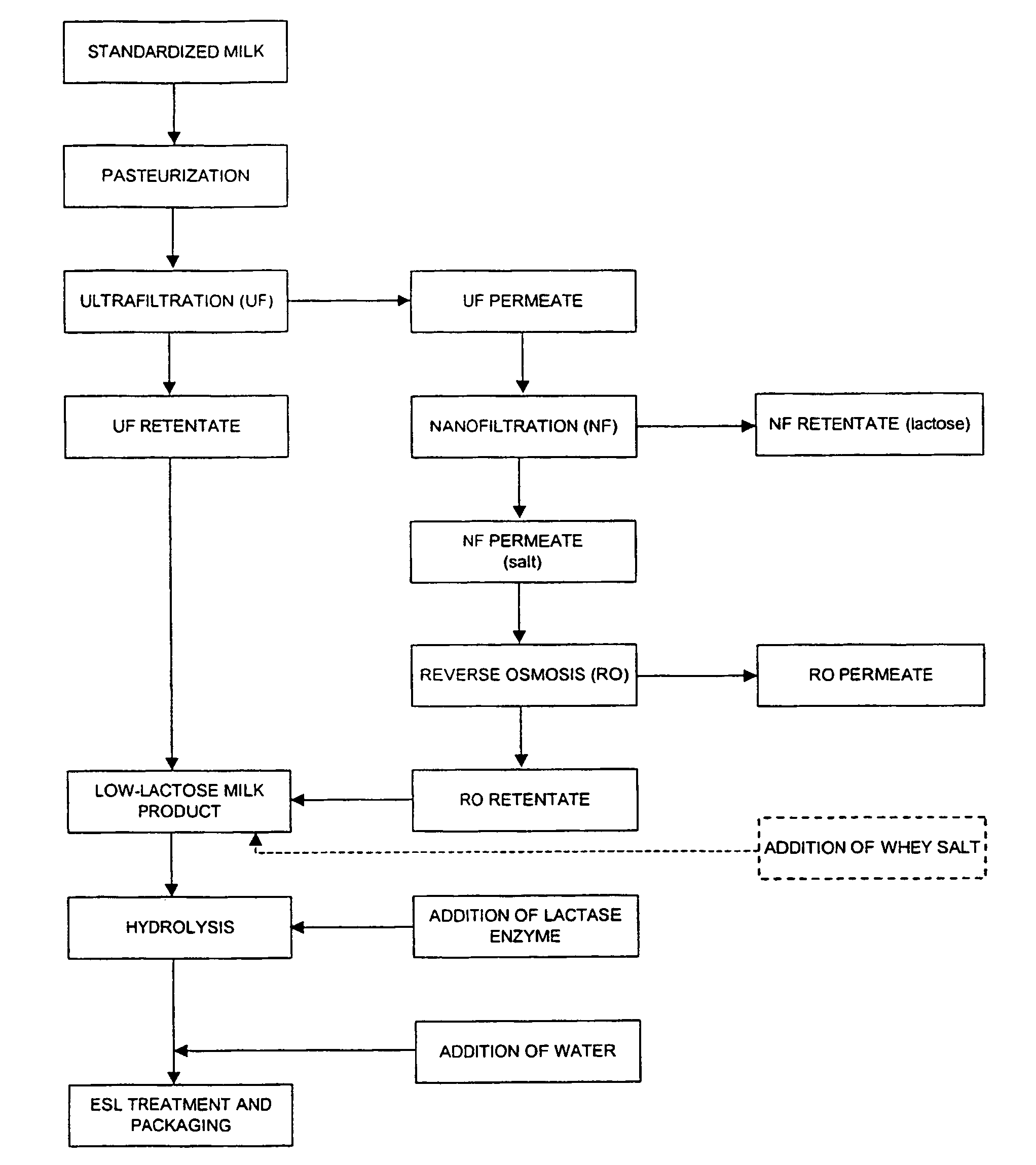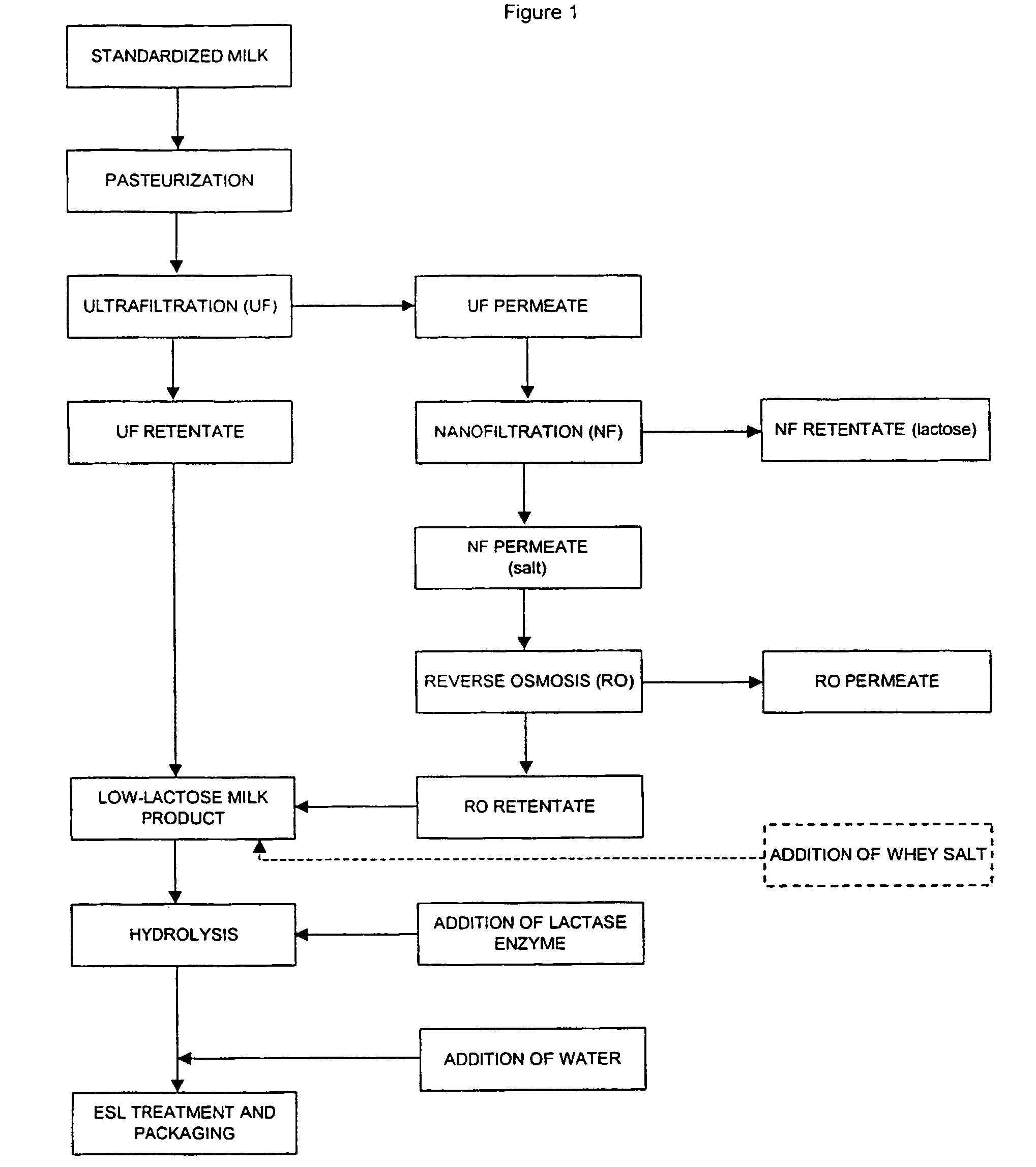Process for producing a lactose-free milk product
a technology of lactose-free milk and process, which is applied in the field of process for producing lactose-free milk products, can solve the problems of intolerant individuals to lactose, lack of energy consumption, and inability to tolerate, and achieve the effect of retaining the organoleptic characteristics of milk products and being easy to be further processed
- Summary
- Abstract
- Description
- Claims
- Application Information
AI Technical Summary
Benefits of technology
Problems solved by technology
Method used
Image
Examples
example 1
[0038]30 liters of pasteurized (72° C., 15 s.) milk having a fat content of 1.5% were ultrafiltered at 50° C. with a laboratory scale Labstak ultrafilter at concentration ratio 1.5 using GR61PP membranes having a cut off value of 20,000 Da. Both the obtained retentate (20 L) and the obtained permeate (10 L) were recovered.
[0039]The UF permeate (10 L) was further nanofiltered at room temperature by concentration coefficient 4 through Millipore Nanomax-50 nanofiltration membranes, whereby univalent ions passed through the membrane (NaCl retention<65%) (7.5 L). The main component of the UF permeate was lactose which was retained in the retentate portion in the nanofiltration. In nanofiltration, salts were eliminated from the UF permeate, i.e. the lactose portion (2.5 L), and therefore the nanofiltration retentate was suitable for further use as a low-sodium lactose fraction.
[0040]The nanofiltration permeate (7.5 L) was concentrated at room temperature using reverse osmosis membranes Na...
example 2
[0044]30 litres of pasteurized (72° C., 15 s.) milk having a fat content of 1.5% are ultrafiltered at 50° C. at concentration ratio 1.5 using GR61PP membranes having a cut off value of 20,000 Da. Both the obtained retentate (20 L) and the obtained permeate (10 L) are recovered.
[0045]Instead of the RO retentate produced from the UF permeate of milk, in cheese dairies, a concentrate (RO retentate) made from the permeate from the nanofiltration of whey is taken, the composition of the concentrate being similar to that of the RO retentate made from the UF permeate of milk (Tables 1 and 2).
[0046]69.2 g UF retentate and 10.5 g salt concentrate, and 20.3 g water are mixed and 0.35 g HA lactase (Chr. Hansen A / S, Denmark) are added. The mixture is allowed to hydrolyze at 10° C. for 24 hours, during which time the lactose content drops below 0.01%. Table 2 shows the compositions of the UF retentate and the RO retentate. The composition of the obtained product is very near ordinary semi-skimme...
example 3
[0049]The milk produced in accordance with example 1 or 2 can also be dried to a powder. The milk is pasteurized at 75° C.±3° C. / 3 min. and evaporated to a 40 to 45% dry matter content. It is then fed into a spray drier. Drying with a laminar drier (Filtermat) is performed at the corresponding drying values as normal lactose-hydrolyzed milk powders.[0050]Nozzle pressure 110 to 150 bar[0051]Temperature of nozzle air 185 to 190° C.[0052]Temperature of laminar air 160 to 170° C.[0053]Post-drying 120 to 130° C.[0054]Cooling 20 to 25° C.[0055]Outlet temperature 60 to 65° C.[0056]Target moisture 1.75%, maximum 2.3%
[0057]The production of powder is particularly suitable for the production of fat-free lactose-free milk powder, but fatty powders may also be produced.
PUM
 Login to View More
Login to View More Abstract
Description
Claims
Application Information
 Login to View More
Login to View More - R&D
- Intellectual Property
- Life Sciences
- Materials
- Tech Scout
- Unparalleled Data Quality
- Higher Quality Content
- 60% Fewer Hallucinations
Browse by: Latest US Patents, China's latest patents, Technical Efficacy Thesaurus, Application Domain, Technology Topic, Popular Technical Reports.
© 2025 PatSnap. All rights reserved.Legal|Privacy policy|Modern Slavery Act Transparency Statement|Sitemap|About US| Contact US: help@patsnap.com



